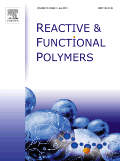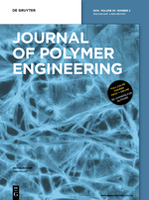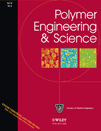
ACS Polymers Au
Scope & Guideline
Catalyzing innovation in materials science and engineering.
Introduction
Aims and Scopes
- Polymer Synthesis and Modification:
The journal emphasizes research on novel synthesis techniques for polymers, including advanced methods like click chemistry, radical polymerization, and enzymatic processes. This includes studies on the modification of existing polymers to enhance their properties and functionalities. - Characterization and Properties of Polymers:
A core focus is on the characterization of polymers and their properties, including mechanical, thermal, and electrical characteristics. The journal seeks to publish works that explore the relationship between polymer structure and its macroscopic properties. - Applications in Biomedical Engineering:
ACS Polymers Au highlights research on polymers used in biomedical applications, such as drug delivery systems, wound care materials, and antimicrobial coatings. The emphasis is on developing biocompatible and biodegradable materials. - Sustainable and Green Polymer Chemistry:
The journal prioritizes research that contributes to sustainability in polymer science, including the use of renewable resources, recycling, and environmentally friendly synthesis methods. Innovations that reduce the environmental impact of polymer production and disposal are particularly valued. - Machine Learning and Computational Approaches:
There is a growing emphasis on the integration of machine learning and computational methods in polymer research, particularly in predicting properties, optimizing synthesis, and understanding complex polymer behaviors at the molecular level. - Nanostructured and Advanced Polymer Materials:
Research on nanostructured polymers, including nanocomposites and hydrogels, is a significant area of interest. The journal publishes studies on the design and application of advanced materials for various technological applications.
Trending and Emerging
- Biopolymer and Biodegradable Materials:
There is a notable increase in research related to biopolymers and biodegradable materials, driven by environmental concerns and the push for sustainable alternatives to conventional plastics. - Smart and Responsive Polymers:
The trend toward smart materials continues to grow, with an emphasis on polymers that respond to environmental stimuli (e.g., pH, temperature, light). These materials are increasingly being applied in drug delivery, sensors, and other advanced applications. - Artificial Intelligence and Machine Learning in Polymer Science:
The integration of AI and machine learning techniques in polymer research is on the rise. This includes using computational methods to predict polymer properties, optimize synthesis processes, and analyze complex data. - Polymer Nanocomposites and Hybrid Materials:
Research focusing on polymer nanocomposites, which combine polymers with nanomaterials to enhance properties, is trending. This includes studies on their applications in electronics, energy storage, and environmental remediation. - Functional Polymers for Energy Applications:
There is a growing interest in polymers designed for energy applications, including solid polymer electrolytes for batteries and energy storage systems. This reflects the broader trend of integrating polymer science with energy technology.
Declining or Waning
- Traditional Polymer Processing Techniques:
There has been a noticeable decline in studies focused on conventional polymer processing techniques, such as extrusion and injection molding. As new methods and materials gain traction, interest in these traditional approaches has diminished. - Basic Polymer Science without Application Focus:
Research that purely explores fundamental polymer science without direct applications or implications for industry seems to be declining. The journal is increasingly favoring studies that connect basic science to practical applications. - Single-Domain Polymer Studies:
There is a reduced emphasis on studies focusing solely on single-domain polymers or simple polymer systems. The trend is shifting towards more complex, multi-functional materials that exhibit novel behaviors. - Legacy Polymer Materials:
Research on older polymer materials, such as certain traditional plastics that have been widely used for decades, is becoming less frequent. The journal is focusing more on innovative materials that address contemporary challenges.
Similar Journals

POLYMER SCIENCE SERIES B
Fostering Excellence in Materials ResearchPOLYMER SCIENCE SERIES B is a distinguished journal published by MAIK NAUKA/INTERPERIODICA/SPRINGER, dedicated to advancing knowledge in the fields of ceramics and composites, materials chemistry, and polymers and plastics. The journal, identifiable by its ISSN 1560-0904 and E-ISSN 1555-6123, spans a significant timeline from 1996 to 2024, reflecting its commitment to preserving and disseminating cutting-edge research in polymer science. With its current ranking in the Q3 category across relevant fields, it supports scholars and professionals in enhancing their understanding and application of polymeric materials. While it operates on a non-open access basis, the journal is pivotal for researchers seeking in-depth analysis and peer-reviewed studies. Located in the heart of the United States at 233 Spring St, New York, NY 10013-1578, POLYMER SCIENCE SERIES B serves as an essential resource for committed researchers, professionals, and students aiming to push the boundaries of polymer science.

INTERNATIONAL JOURNAL OF POLYMER ANALYSIS AND CHARACTERIZATION
Pioneering research in analytical chemistry and polymers.International Journal of Polymer Analysis and Characterization is a distinguished scholarly publication dedicated to the field of polymer science, with a focus on innovative methodologies and significant advances in the analysis and characterization of polymeric materials. Published by Taylor & Francis Ltd in the United Kingdom, this journal serves as a vital resource for researchers, professionals, and students deeply engaged in Analytical Chemistry, Chemical Engineering, and Polymer Science. With a convergence spanning from 1995 to 2024, it holds a Q3 ranking in the 2023 category quartiles for its valuable contributions to the fields of Analytical Chemistry, Chemical Engineering, and Polymers and Plastics. Despite being a non-open access publication, its rigorous peer-review process and comprehensive coverage of current trends ensure that the journal remains a crucial platform for disseminating impactful research. The journal is indexed in various databases, underscoring its relevance and quality in the academic community. Exploratory studies and articles that push the boundaries of polymer analysis find a welcoming home within these pages, making it an essential read for those aiming to stay at the forefront of polymer research.

POLYMER INTERNATIONAL
Connecting Researchers to Cutting-edge Polymer InsightsPOLYMER INTERNATIONAL is a leading journal in the field of polymer science, published by Wiley, one of the most esteemed scholarly publishers. With an ISSN of 0959-8103 and an E-ISSN of 1097-0126, this journal has been a pivotal platform for researchers since its inception in 1991, now extending its coverage until 2024. The journal boasts a commendable standing in various scientific domains, achieving a Q2 quartile ranking in Materials Chemistry, Organic Chemistry, and Polymers and Plastics as of 2023. Additionally, it holds impressive Scopus ranks, including Rank #47 in Organic Chemistry and Rank #40 in Polymers and Plastics, placing it within the top percentiles of its categories. Researchers, professionals, and students alike can benefit from its rich array of articles that contribute to the understanding and advancement of polymer technology and materials science. Although not an open access journal, POLYMER INTERNATIONAL remains crucial for disseminating high-quality research that drives innovation and development within the field.

MACROMOLECULAR RESEARCH
Unlocking the Potential of Polymers WorldwideMACROMOLECULAR RESEARCH, published by the POLYMER SOC KOREA, is a premier journal dedicated to advancing the field of macromolecular science and polymer engineering. With its ISSN 1598-5032 and E-ISSN 2092-7673, this journal has emerged as a vital platform for researchers and professionals interested in the application and development of polymers across various domains. Based in South Korea and operating as an open-access resource since its inception in 2002, MACROMOLECULAR RESEARCH consistently ranks in the Q2 category across diverse fields such as Chemical Engineering, Materials Chemistry, and Organic Chemistry as per the latest 2023 metrics. Notably, it is recognized for its substantial contributions to polymery science, increasing its visibility and impact in global research. By providing a forum for original research articles, reviews, and innovative methodologies, this journal aims to foster collaboration and knowledge sharing among scientists, engineers, and students alike. Join a community that is at the forefront of polymer research by exploring the wealth of resources and cutting-edge studies featured in MACROMOLECULAR RESEARCH.

REACTIVE & FUNCTIONAL POLYMERS
Pioneering Research for a Sustainable Polymer FutureREACTIVE & FUNCTIONAL POLYMERS, published by Elsevier, is a leading journal in the field of polymer science, focusing on the innovative development and application of reactive and functional polymers. With an impressive impact demonstrated through its classification in various prestigious categories, including Q1 rankings in Chemical Engineering, Chemistry, and Materials Chemistry, this journal serves as an essential resource for researchers and professionals seeking to explore the latest advances in polymer research. With a broad scope that encompasses topics from biochemistry to environmental chemistry, and a convergence of significant findings from 1995 to 2024, REACTIVE & FUNCTIONAL POLYMERS fosters academic dialogue and collaboration among scientists. The journal also features Open Access options, ensuring that groundbreaking research is readily available to a global audience. By consistently publishing high-quality articles, it not only enriches the scientific community but also drives innovation across various industries reliant on polymer technologies.

JOURNAL OF APPLIED POLYMER SCIENCE
Shaping the Future of Materials Through PolymersThe Journal of Applied Polymer Science, published by Wiley, is a leading journal in the field of polymer science, showcasing innovative research and applications in various domains since its inception in 1959. With an ISSN of 0021-8995 and an E-ISSN of 1097-4628, it is indexed in prominent databases, maintaining a strong presence with Scopus rankings placing it in the Q2 category across multiple disciplines, including Chemistry, Materials Chemistry, and Polymers and Plastics. The journal’s commitment to advancing scientific knowledge is reflected in its impact on the materials science community, with noteworthy rankings such as #38 in Surfaces, Coatings and Films and #51 in Polymers and Plastics. Though not an open-access publication, it remains a vital resource for researchers, professionals, and students aiming to deepen their understanding of polymer applications and to stay abreast of the latest developments in this ever-evolving field. With a focus on high-quality research, the Journal of Applied Polymer Science continues to be a cornerstone for those engaged in polymer research and its myriad applications.

JOURNAL OF POLYMER ENGINEERING
Exploring the Boundaries of Materials Chemistry.JOURNAL OF POLYMER ENGINEERING, published by Walter de Gruyter GmbH, stands as a pivotal platform in the field of polymer science and engineering. With an ISSN of 0334-6447 and an E-ISSN of 2191-0340, this journal has been a vital contributor to the academic landscape since its inception, spanning publications from 1981 to 2024. As a recognized entity in the realms of Chemical Engineering, Materials Chemistry, and Polymers and Plastics, it holds a respectable position in Q3 quartile rankings according to the latest assessments. The journal is positioned to promote the exchange of cutting-edge research findings, technological advancements, and critical reviews that address the complexities of polymer application and innovation. Researchers and professionals will find a wealth of information, from experimental methodologies to theoretical analyses, all designed to inspire and elevate the current understanding of polymer engineering. By fostering collaboration and dissemination of knowledge, the JOURNAL OF POLYMER ENGINEERING remains crucial for advancing research and education in its specialized domains.

JOURNAL OF POLYMER RESEARCH
Unveiling Cutting-Edge Research in PolymersJOURNAL OF POLYMER RESEARCH is a leading peer-reviewed journal published by SPRINGER, specializing in the dynamic fields of polymer science, materials chemistry, and organic chemistry. Operating since 1994, this esteemed journal has consistently delivered high-quality research articles that illuminate the latest advancements and innovations in polymer technology. With an increasing impact factor and placed in the Q2 category for both Materials Chemistry and Polymers and Plastics, it stands as a valuable resource for researchers, professionals, and students seeking cutting-edge knowledge in these areas. The journal is indexed in Scopus, highlighting its significance in the academic community, with notable rankings in Materials Science and Organic Chemistry. While it does not currently offer open access options, the meticulous selection of research and thorough peer-review process ensures each article's contribution to the field is both robust and impactful. Researchers aiming to expand their understanding and engage with pioneering studies will find JOURNAL OF POLYMER RESEARCH an indispensable platform.

POLYMER ENGINEERING AND SCIENCE
Connecting Researchers in Polymer SciencePOLYMER ENGINEERING AND SCIENCE, published by WILEY, is a premier journal specializing in the field of polymer science and engineering. Since its inception in 1961, this journal has been at the forefront of disseminating high-quality research, focusing on various aspects of polymers and plastics, including their chemistry, properties, and applications. With an impressive impact factor, it ranks in the second quartile (Q2) across multiple categories, including Chemistry (Miscellaneous), Materials Chemistry, and Polymers and Plastics, showcasing the journal's significance and influence in these vital areas of research. Researchers and professionals in academia and industry will find the latest advancements and innovative methodologies in polymer science, making this journal an essential resource for those looking to stay updated on cutting-edge developments. While it does not currently support Open Access, its comprehensive scope and critical insights positioned it as a valuable platform for advancing knowledge and fostering collaboration within the polymer community. The journal’s office is located at 111 River St, Hoboken 07030-5774, NJ, United States, emphasizing its strong presence in the academic landscape.

POLYMER BULLETIN
Elevating Standards in Polymer Science and TechnologyPOLYMER BULLETIN is a prominent journal in the field of polymer science, published by SPRINGER in Germany. Established in 1978, this peer-reviewed journal focuses on the latest research and developments in polymer chemistry, materials science, and condensed matter physics, boasting a commendable impact factor indicative of its rigorous academic standards. With a Q2 ranking in multiple categories including Chemistry (Miscellaneous), Condensed Matter Physics, Materials Chemistry, and Polymers and Plastics, POLYMER BULLETIN serves as an essential resource for researchers, professionals, and students aiming to stay abreast of innovative findings and methodologies within these interdisciplinary landscapes. Although the journal does not currently offer open access, it provides invaluable insights and data that significantly contribute to the advancement of polymer science. For more information and to access published articles, visit the journal's page on the Springer website.